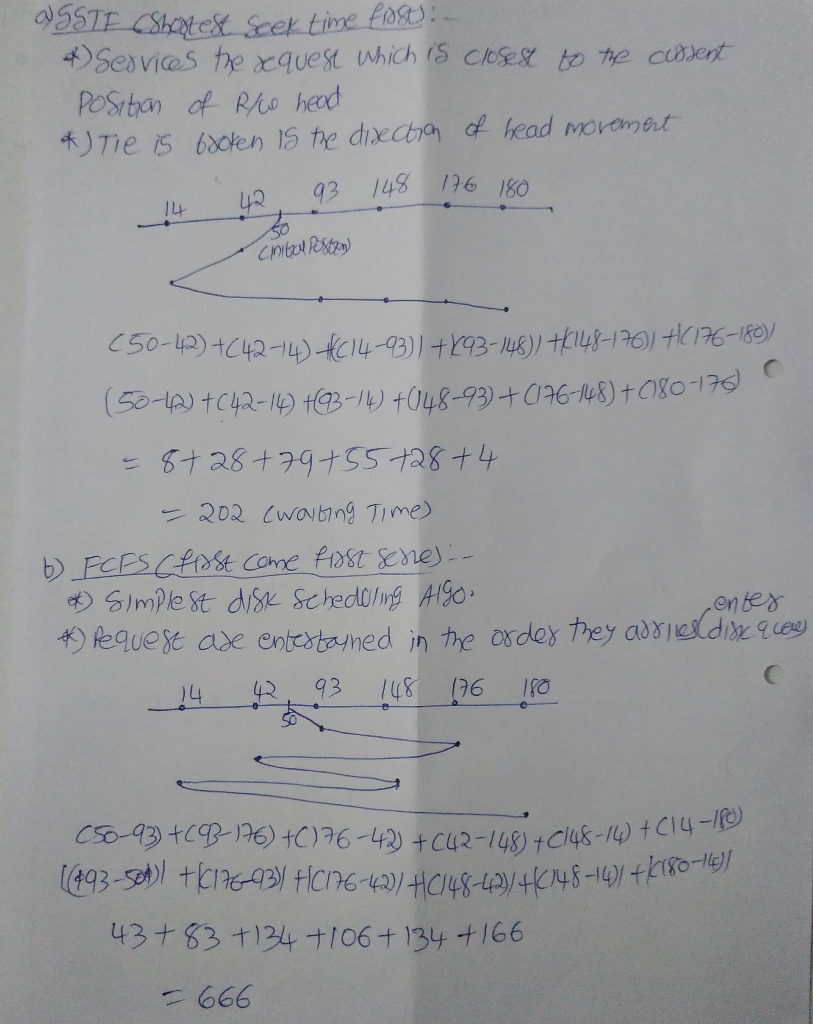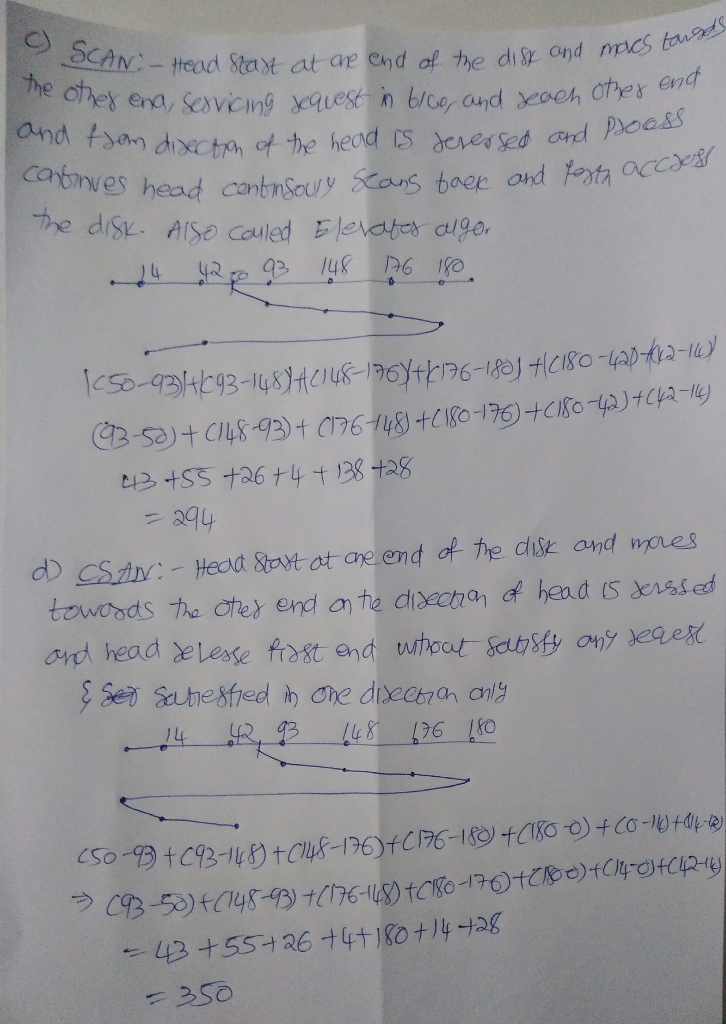Question
In: Computer Science
Explain the shortest seek time first, first come first serve, scan, and c scan algorithms of...
Explain the shortest seek time first, first come first serve, scan, and c scan algorithms of storage management algorithms with the single of the sequence (93, 176, 42, 148, 14, 180).
Draw good diagrams and CALCULATE the total distance traveled and the total waiting time.
initial position is at 50
Solutions
Expert Solution

 i
am done perfectly but for scan and c scan starting and ending
points not given direction of head movement not there so not unique
answers
i
am done perfectly but for scan and c scan starting and ending
points not given direction of head movement not there so not unique
answers
Anything doubtful or not understand just comment I will touch with you
Thank you and all the best
Related Solutions
Scheduling Algorithms Part 1 First Come First Serve Consider the following processes along with their burst...
Scheduling Algorithms
Part 1
First Come First
Serve
Consider the following processes along
with their burst time (in Calculate the average waiting time if the
processes arrive in the following order
Process
Burst Time in Ms
P1
20
P2
10
P3
5
Calculate the average waiting time if
the processes arrive in the following order
(i)P1, P2, P3
(ii)P2, P3, P1
(i) Case 1: Consider
a case if processes P1, P2, P3 arrive at the same
time say 0 ms...
List of six process scheduling algorithms (for operating systems): First-Come, First-Served (FCFS) Scheduling Shortest-Job-Next (SJN) Scheduling...
List of six process scheduling algorithms (for operating
systems):
First-Come, First-Served (FCFS) Scheduling
Shortest-Job-Next (SJN) Scheduling
Priority Scheduling
Shortest Remaining Time
Round Robin(RR) Scheduling
Multiple-Level Queues Scheduling
Compare and contrast the algorithms against one another here.
You have at least six algorithms, so this should be an extensive
part of the project, and all research based.
First-Come, First-Served (FCFS) Scheduling Shortest-Job-Next (SJN) Scheduling Priority Scheduling Shortest Remaining Time Round Robin(RR) Scheduling Multiple-Level...
First-Come, First-Served (FCFS) Scheduling
Shortest-Job-Next (SJN) Scheduling
Priority Scheduling
Shortest Remaining Time
Round Robin(RR) Scheduling
Multiple-Level Queues Scheduling
Provide a timing example of each of the algorithms above. List
some processes (at least four) with the appropriate properties for
creating a time diagram (such as Process ID, Arrival Time, Burst
Time, and Execution Time). Walk through the timing diagram
identifying the algorithm you’re using and state which process goes
first, which process finishes first, etc.
in C++ We are going to implement the following scheduling algorithms 1. First-Come First-Served (FCFS) 2....
in C++
We are going to implement the following scheduling
algorithms
1. First-Come First-Served (FCFS)
2. Shortest Remaining Time First (SRTF)
3. Highest Response Ratio Next (HRRN)
4. Round Robin, with di_erent quantum values (RR)
We are interested to compute the following metrics, for each
experiment:
_ The average turnaround time
_ The total throughput (number of processes done per unit
time)
_ The CPU utilization
_ The average number of processes in the ready queue
The simulator needs to...
For First Come First Served (FCFS), -What is the arrival time, completion time, burst time, turnaround...
For First Come First Served (FCFS),
-What is the arrival time,
completion time, burst time, turnaround time, and the waiting
time?
-discuss these terms further as
they pertain to the efficiency of the algorithm as well as
properties such as starvation.
-Pros and Cons of FCFS
Cerner Corporation announced a first-come, first-serve stock repurchase offer to its shareholders – the company agreed...
Cerner Corporation announced a first-come, first-serve stock
repurchase offer to its shareholders – the company agreed to
repurchase 2,653,780 shares of its common stock in exchange for
total consideration of $173,434,000. Cerner had 329,641,500 total
shares outstanding before the redemption. You acquired 16,482,075
shares of Cerner's stock two years ago for $20/share. You were the
only shareholder to participate in the repurchase offer and Cerner
agreed to redeem the total number of shares directly from you.
Choose the response that...
Cerner Corporation announced a first-come, first-serve stock repurchase offer to its shareholders – the company agreed...
Cerner Corporation announced a first-come, first-serve stock
repurchase offer to its shareholders – the company agreed to
repurchase 2,653,780 shares of its common stock in exchange for
total consideration of $173,434,000. Cerner had 329,641,500 total
shares outstanding before the redemption.
You acquired 16,482,075 shares of Cerner's stock two years ago
for $20/share. You were the only shareholder to participate in the
repurchase offer and Cerner agreed to redeem the total number of
shares directly from you.
Using the applicable tax...
Cerner Corporation announced a first-come, first-serve stock repurchase offer to its shareholders – the company agreed...
Cerner Corporation announced a first-come, first-serve stock
repurchase offer to its shareholders – the company agreed to
repurchase 2,653,780 shares of its common stock in exchange for
total consideration of $173,434,000. Cerner had 329,641,500 total
shares outstanding before the redemption. You acquired 16,482,075
shares of Cerner's stock two years ago for $20/share. You were the
only shareholder to participate in the repurchase offer and Cerner
agreed to redeem the total number of shares directly from you.
Using the applicable tax...
Bellman-Ford and Dijkstra's algorithms solve the single-source shortest path (SSSP) problem. Explain the circumstances when you...
Bellman-Ford and Dijkstra's algorithms solve the single-source
shortest path (SSSP) problem. Explain the circumstances when you
would use each of these algorithms.
1. What is the average waiting time for Processes If the Operating System uses the Shortest-Job-First...
1. What is the average waiting time for Processes If the
Operating System uses the Shortest-Job-First (SJF) Scheduling
Algorithm?
(P1=5 ms, P2=10 ms, P3=15 ms)
2. How many page faults occur in the Optimum Page Replacement
algorithm (OPR) with the following reference string for three-page
frames?
Reference String: 4,2,1,3,2,3,4,1
3. What is the average waiting time for Processes If the
Operating System uses Shortest-Job-Remaining-First (SJRF)
Scheduling Algorithm?
(P1=5 ms, P2=10 ms, P3=15 ms)
Arrival Time ( P1=0 ms, P2=5...
ADVERTISEMENT
ADVERTISEMENT
Latest Questions
- Exercise 1: Write a C program that does the following tasks: a. Declare a structure called...
- a centrifugal pump has an impeller of outer diameter 230mm and an inner diameter of 150mm....
- The City of St. Louis, Mississippi (population just under 24,000) passed a bond issue for $2,500,000,...
- Suppose the economy is suffering from high rates of unemployment. What kind of fiscal policy should...
- A car accelerates uniformly from rest to 26.5 m/s in 8.60 s along a level stretch...
- Project 4 Prepare a chart of your major expenses and check the impact of inflation by...
- What are the trends in the national minimum wage for the UK? Please answer in an...
ADVERTISEMENT
 venereology answered 1 month ago
venereology answered 1 month ago